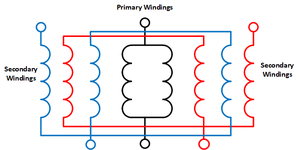sabu31
Advanced Member level 1
Dear All,
I need to design a pulse transformer with input 500V, output 4kV. Pulse width 10us and rise time 1us. Load on secondary 60 Ohms. I have made pulse transformer however, there are still issues of ringing. I came across a paper which mentions a particular configuration of secondary winding which gives tight coupling. I understand that primary is wound on two legs of C core and are connected in parallel. But not able to understand secondary winding configuration. I am attaching the figure. Could someone translate it to a physical connection on a C core.
Thanks in Advance
I need to design a pulse transformer with input 500V, output 4kV. Pulse width 10us and rise time 1us. Load on secondary 60 Ohms. I have made pulse transformer however, there are still issues of ringing. I came across a paper which mentions a particular configuration of secondary winding which gives tight coupling. I understand that primary is wound on two legs of C core and are connected in parallel. But not able to understand secondary winding configuration. I am attaching the figure. Could someone translate it to a physical connection on a C core.
Thanks in Advance
